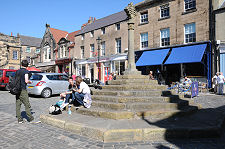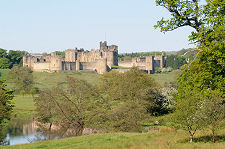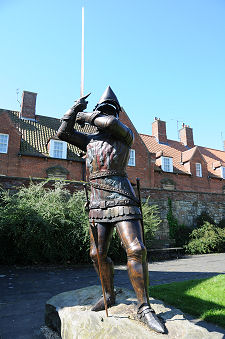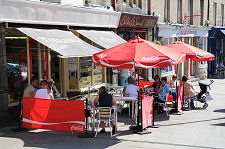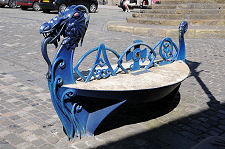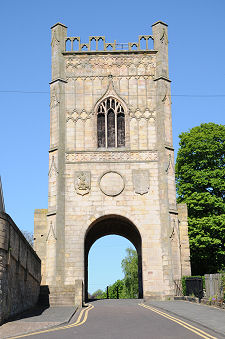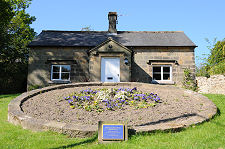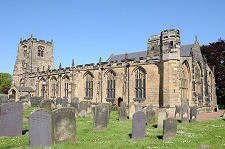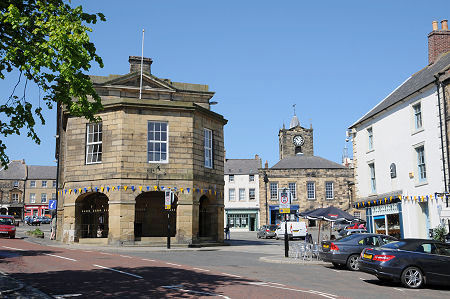 Northumberland Hall and Market Place |
No visitor to Northumberland should miss Alnwick. It stands approximately half the way up the length of the county some four miles inland from the coast and just to the west of the main A1 road. The town itself was built on gently sloping ground on the south side of the River Aln and is one of the most attractive you will find anywhere. And if that were not enough of an incentive to visit, it is also home to Alnwick Castle, one of the largest inhabited castles in Europe, and to the spectacular Alnwick Garden.
The story of Alnwick is inseparable from the story of its castle, and for the past seven hundred years that in turn has been inseparable from the story of the Percy family, the Earls and later the Dukes of Northumberland. Alnwick probably first appeared on the landscape during the Anglo-Saxon period close to a ford across the River Aln on the main north-south route through Northumbria. In the aftermath of the Norman Conquest, estates in the area were granted to Gilbert de Tesson (or Gilbert Tyson), a follower of William I. De Tesson probably built a motte and bailey castle with wooden defences overlooking the crossing of the Aln, and it was during his tenure, in 1093, that King Malcolm III of Scotland was killed in the First Battle of Alnwick, on the north side of the river opposite the town.
In 1096 De Tesson took part in an ill fated uprising against William II. He was stripped of his estates, and Alnwick was awarded instead to Ivo de Vesci, a Norman nobleman who later became 1st Baron of Alnwick. It was the De Vesci family who began to build in stone at Alnwick Castle, and parts of what you can see today date back to the mid 1100s. In 1174 the Second Battle of Alnwick took place on what is now the western edge of the town, and another Scottish king, William the Lion, was captured.
Alnwick was home to two important religious foundations. Alnwick Abbey was founded by the Premonstratensian Order in 1147 on a site on the north bank of the River Aln just to the north-west of the town. It was suppressed in 1539. All that remains today is an imposing gatehouse, standing within Hulne Park, part of the estates of the Duke of Northumberland. Meanwhile, Hulne Priory was founded in 1242 on a site beside the River Aln two miles north-west of Alnwick. A Northumbrian soldier, Ralph Fresborn had visited the monastery on Mount Carmel (in what is now Israel) during a crusade and became a monk. William de Vesci later met him there, also while on crusade, and persuaded him to establish a daughter house in Northumberland. The site chosen by Fresborn was at Hulne. Hulne Priory prospered over the following centuries, and the priory gathered a library of over 100 manuscripts. It was later walled for protection. The priory fell into disuse after the Reformation, but significant remains still stand today, also within Hulne Park.
In 1297 Alnwick Castle fought off an attack by Scots under the command of William Wallace. Alnwick remained in the hands of the De Vesci, or Vescy, family until the last of them died without legitimate heirs in 1297. The Barony of Alnwick was then granted to Bishop Anthony Bek of Durham, who in 1309 sold it to Lord Henry Percy, thus beginning the link between the Percy family and Alnwick that continues today. The Percys did a great deal to develop Alnwick Castle, and the remarkable building you see now is very much their creation.
Alnwick itself suffered from the attentions of a number of visiting Scottish raiding parties or full blown armies over the centuries, and it was badly damaged in the winter of 1424. It was perhaps in response to this event that a "licence to wall and embattle" the town was granted in 1433. Progress was slow and the walls appear to have been incomplete when another Scottish army again badly damaged Alnwick in 1448. The main evidence of the town walls on view today is the massive Hotspur Gate or Bondgate Tower, which remains such a dominant feature on the main road into the town centre from the south-east. Another gate in the walls stood on the spot now occupied by Pottergate Tower. The tower you see today dates back to 1768, though might incorporate some of the stone of the original medieval gateway. If Pottergate tower is imposing today, it was much more so when originally built, complete with a decorative stone crown that was removed in 1812.
Walls gave Alnwick rather more security than it had before, and the increasing wealth that accompanied it was reflected in a number of medieval churches, most notably the Church of St Michael. Another, St Mary's Chantry House, only survived into the 1700s, though its ruins can still be seen on Pottergate. The rest of the town developed within its walls along typical medieval lines, with long plots running back from the houses, shops and workplaces lining the main streets.
Alnwick Castle fell into disuse in the 1500s and 1600s, and it was Hugh Percy, 1st Duke of Northumberland, who commissioned a major renovation and restoration programme in the late 1700s, using the architect Robert Adam. The result was the palace you can still see today, surrounded by landscaped gardens and parks.
Although Alnwick stood astride the Great North Road (the A1) until it was bypassed in 1968, it was only ever served by a branch line railway which departed from the East Coast Main Line at Alnmouth. This opened in 1850, and closed in 1968. Today the station, which stands on the south-east edge of the town centre, is home to Barter Books, one of the largest secondhand bookshops in Britain.
Opposite the old station, standing on top of a small hill in a park, is the Percy Tenantry Column, an imposing if perhaps misguided expression of gratitude by his tenants to the Duke of Northumberland. Nearby is a roundabout over looked by the "Wager Cottage" allegedly built in a fortnight. The roundabout is home to Alnwick's war memorial and marks the end of Bondgate Without. Following this takes you into the centre of Alnwick, passing Alnwick Playhouse and the Hotspur Gate en route.
Beyond the gate is Bondgate Within, which opens out into a broad sweeping street that is very attractive, but would be even more so without the vehicles parking in it and driving through it (like just about anywhere else). The White Swan Hotel dominates one side of the street, revealing Alnwick's coaching heritage. Further on, Market Street is separated from the Market Place by Northumberland Hall, built in 1826, and home to the Tourist Information Centre and public conveniences. At one end of the Market Place is the Market Cross, while at the other is the rear of the fairly modestly sized Town Hall, built in 1731.
The Town Hall fronts onto Fenkle Street, and this continues into the very pretty Narrowgate, which as you progress becomes home on one side to the castle walls. The far end of Narrowgate broadens out into an open area which gives access to Alnwick Castle on one side. Leading off in the other direction is Baliffgate, where you find the Baliffgate Museum and the Church of St Michael.
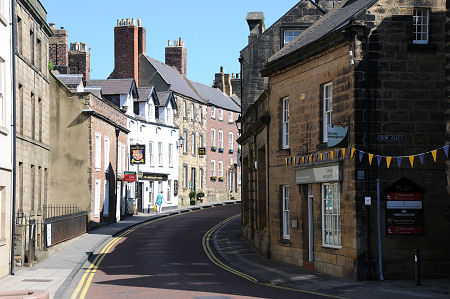 Narrowgate, Looking Up Towards Alnwick Castle |
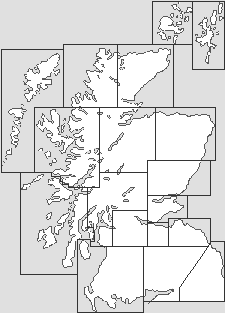
|
|
|
Visitor InformationView Location on MapWhat3Words Location: ///broadens.darling.basic |
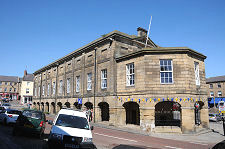 Northumberland Hall |
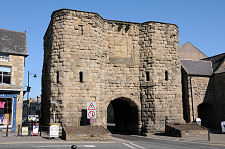 The Hotspur Gate |
 Narowgate, with Castle Wall on Left |
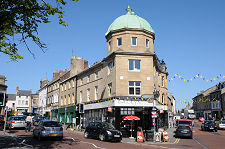 Market Street |
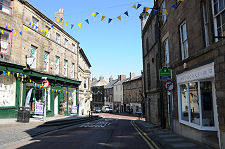 Fenkle Street |
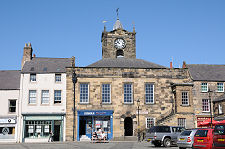 The Town Hall |
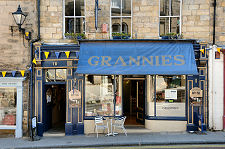 Grannies Tea Shop |
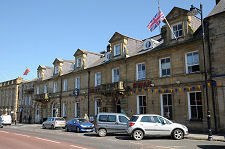 White Swan Hotel |
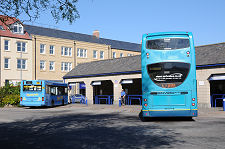 Bus Station |
